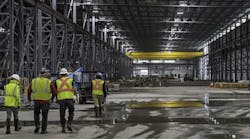Architects have been busy in 2004. That’s good news for electrical distributors, reps and manufacturers, because those plans are now starting to turn into actual construction projects. An economist has figured out how to use the level of billings at architectural firms as a leading economic indicator to forecast future construction trends.
At McGraw-Hill Construction’s Outlook 2005, held Oct. 28 in Washington, D.C., Kermit Baker, chief economist, American Institute of Architects (AIA), Washington, D.C., presented the latest AIA Work-on-the-Boards survey, which tracks billings and inquiries at architectural firms on a monthly basis. Baker said these billings lead all private nonresidential construction starts as measured by U.S. Census by at least six months, and lead commercial/industrial construction projects by nine months. Baker said there was a “strong recovery in 2004 at U.S. architectural firms after years of weakness.”
Architects participating in the AIA Work-on-the-Boards survey are optimistic about 2005: 42 percent expected their billing to be increase 5 percent to 10 percent; 30 percent expected billings to remain the same as in 2004; 8 percent expected billings to increase 10 percent or more. On the flip side, 8 percent expected 2005 billings to be down 10 percent or more, and 12 percent expected billings to be down 5 percent to 10 percent.








